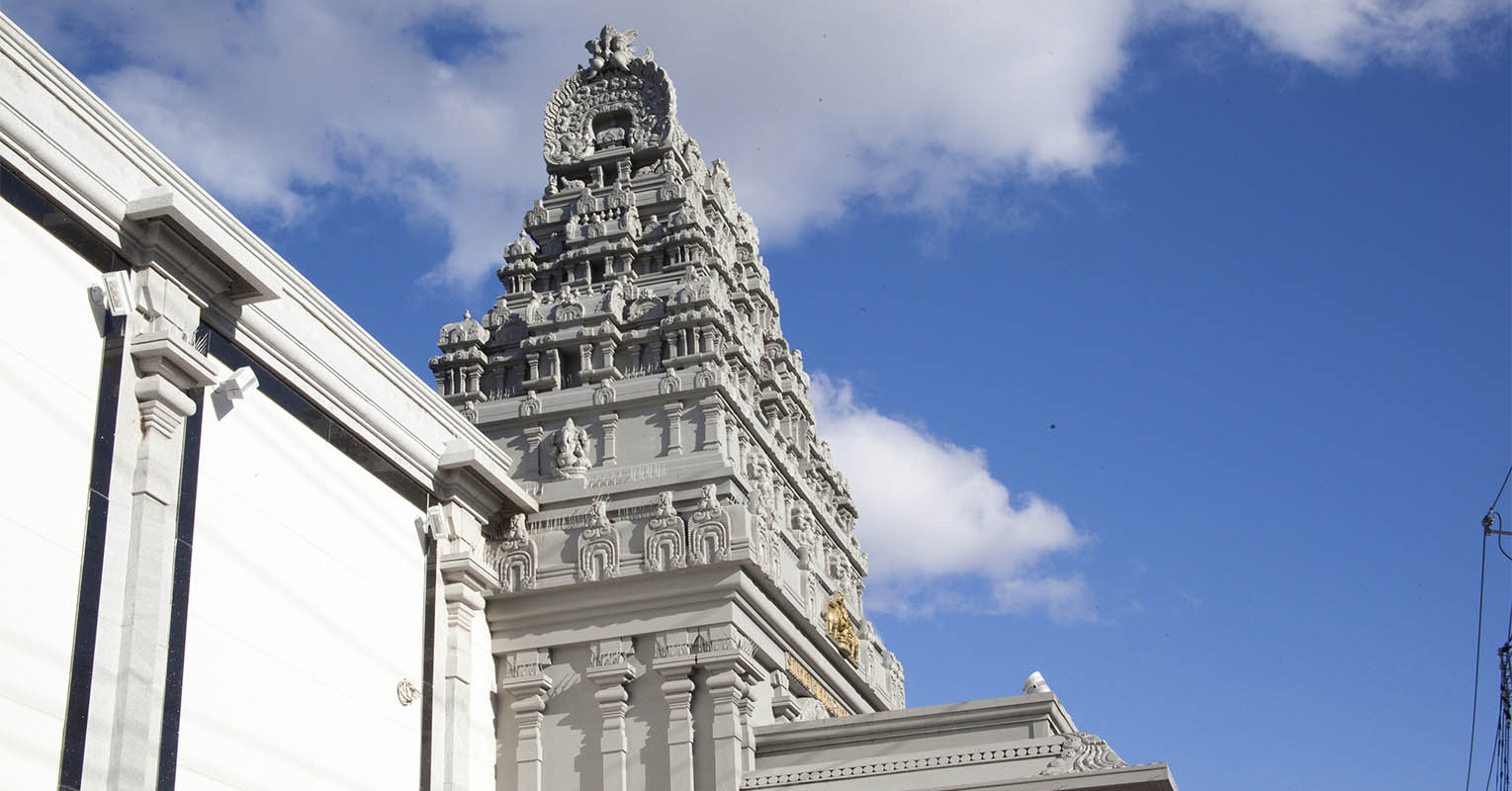Flushing, Queens is one of the most vibrant, culturally diverse, and historic places in New York City. It has adventurous dining options, traditional and modern clothing stores, quiet parks and a botanical garden, and both historic and new architecture, as well as many Chinese and Korean gems. With famous sites like Citi Field and Flushing-Meadows Park, people from all over the U.S. travel to Flushing yearly, many stopping in downtown for delicious Chinese cuisine and views of Manhattan.
Yet, Flushing has a fascinating history to it dating back over 400 years to the arrival of Dutch settlers. While we think of Flushing today as one of the most built-up areas of Queens, many of these historical sites still remain amidst very modern developments. What many New York residents don’t know is that Flushing houses a Freedom Mile, which contains over fifteen historical sites that are off the beaten path, each with their own complex history. But beyond that, there are more hidden gems tucked right in the midst of Flushing’s built environment if you know where to look.
1. World’s Fair Time Capsule
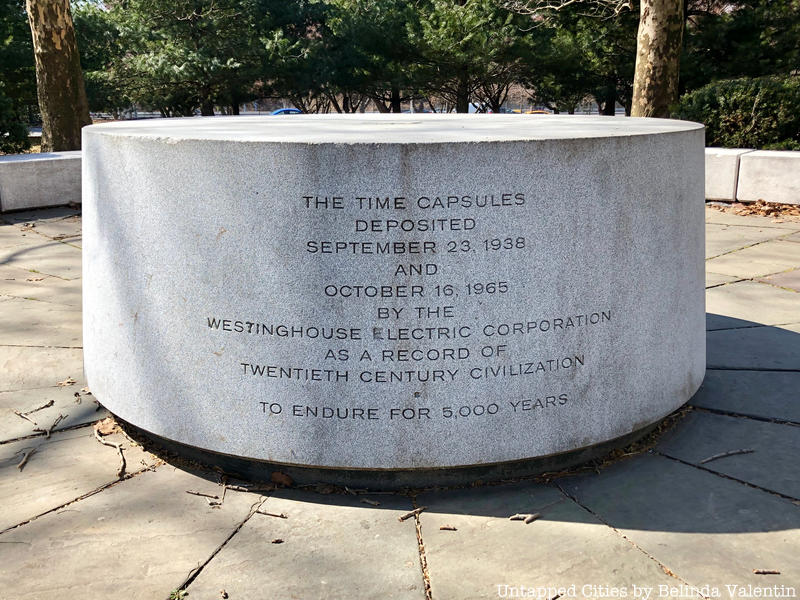
In Flushing Meadows-Corona Park, an 800-pound tube that comprises 35 items like copies of Life magazine, seeds preserved in inert argon and nitrogen gas, and a Sears Roebuck catalogue was lowered 50 feet into the ground on September 23, 1938. The capsule was buried at the site of the Westinghouse Electric & Manufacturing Company exhibit at the 1939-1940 World’s Fair.
The capsule is to be unearthed in 5,000 years, and a report was published on how to properly recover it if geographic boundaries or even loss of modern timekeeping changes. You can find a marker to the time capsule in Flushing Meadows-Corona Park and learn more about this and other secrets on our Tour of the Remnants of the World’s Fairs.
2. A Hindu Temple in Flushing with Hidden Canteen
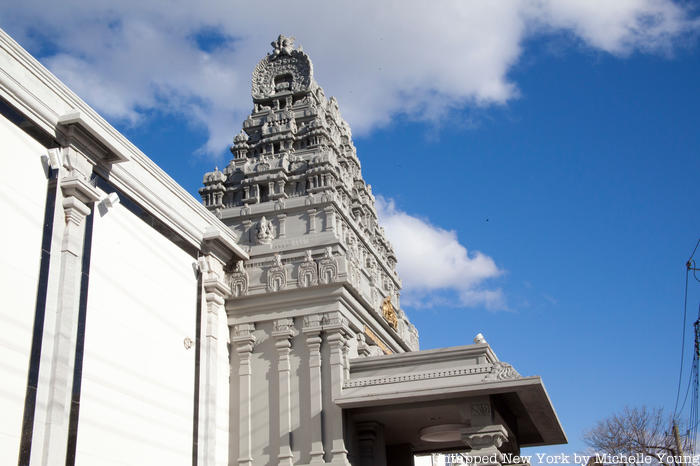
About a mile away from Flushing Main Street in a residential area lies Ganesh Temple, an ornate structure that stands out from its quasi-suburban surroundings. But the real secret is the located in the basement: a hidden restaurant known as “The Canteen.” It began began in 1993 to prepare “naivedyam” or “food offerings” and now features a large selection of South Indian vegetarian options. This hidden dining spot is featured in our book New York Hidden Bars & Restaurants and on Anthony Bourdain’s show No Reservations. He called the food “relentlessly authentic.”
The cafeteria-style dining room consists of a counter with tables and metal chairs spread out throughout the large space. Most dishes are prepared fresh like their dosas, cooked thin rice batter served with chutney and vegetable curry. They also have a selection of regional dosas like Pondicherry or Rava dosa, in addition to uttapam, which is thicker and fluffier than a dosa. Also popular are their snacks like idli, savory rice cakes, and vada, fried doughnuts.
The ornately-designed temple also houses a gift shop open to all visitors and many paintings throughout the temple depicting Hindu deities, and is home to The Hindu Temple Society of North America.
3. The Lewis Latimer House
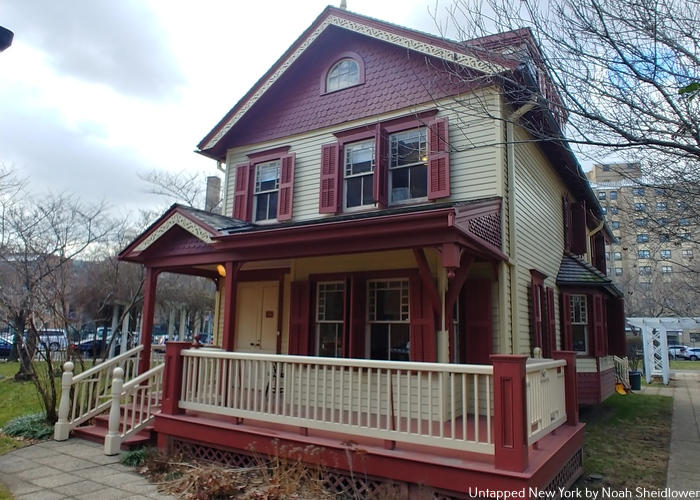
Victorian houses might not be what you associate with Flushing, but just north of Northern Boulevard, you’ll find the Lewis Latimer House which honors Lewis Howard Latimer, an African American inventor and humanist born to fugitive slaves. Latimer, one of the founders of the Unitarian Universalist Congregation in Queens, lived in this Victorian home from 1903 until his death in 1928. The red and white house, which dates back to around 1889, contains a museum dedicated to Latimer’s work and the achievements of other black scientists.
His father, George Latimer, escaped from Virginia to Boston and was subsequently captured and imprisoned, which led to the publication of “The Latimer Journal, and the North Star” and efforts by abolitionists like Frederick Douglass to grant George freedom. Growing up in the antebellum period before the Civil War, Lewis Latimer joined the Union Navy in 1864 and later became an expert draftsman while working at a patent law office. Latimer worked with inventors Hiram S. Maxim, Alexander Graham Bell, and Thomas Alva Edison, under whom he invented and patented the carbon filament, which improved the production of the incandescent lightbulb. He also authored “Incandescent Lighting,” the foundation for modern electrical engineering theory.
4. Willets Point

Located right next to Flushing is Willets Point, a name familiar to Mets fans due to its proximity to Citi Field. With close to no permanent residents, Willets Point is known as the Iron Triangle due to its abundance of automobile shops and junkyards. Willets Point is home to about 225 businesses that employ about 1,700 workers.
Willets Point has faced many recent efforts to demolish and redevelop the area, and today, you can find large swaths of the former Willets Point emptied. Efforts to redevelop the area began as early as World War II, but no progress was made when junkyard owners hired Mario Cuomo as their lawyer.
The De Blasio administration proposed that 1,100 lower- and middle-class apartments, a school, parks, and retail space would be built in the next decade, with all toxic materials cleared from Willets Point by 2020. Despite these efforts, Willets Point still maintains much of its industry and serves as a fascinating yet puzzling place in the Flushing area. Take a visit before it’s all gone.
5. Old Quaker Meeting House
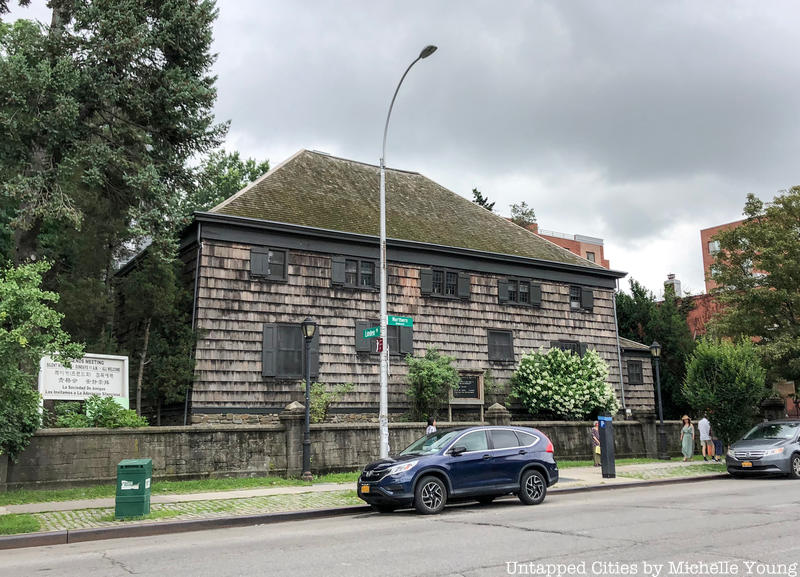
Also known as the Friends Meeting House, this structure on Northern Boulevard was the first house of worship in the village of Flushing, built in 1694. It is the oldest house of worship in New York City and the second oldest Quaker meeting house in the United States. It was also the second meeting house built on Long Island, with one in Oyster Bay built in 1672 that no longer stands.
John Bowne, who secured the land on which the meeting house was built, is believed to be buried in the graveyard behind the house. Since no headstones were put up in the graveyard at first, many plots are still not identified. Buried in the graveyard are prominent abolitionists William Burling and Matthew Franklin, and founder of the New York Gas Light Company Samuel Leggett.
During the American Revolution, the house was converted by the British into a prison, hospital, and barracks for soldiers. It was returned to the Quakers in 1783 following the war.
6. Mosaic Dedicated to Robert Moses
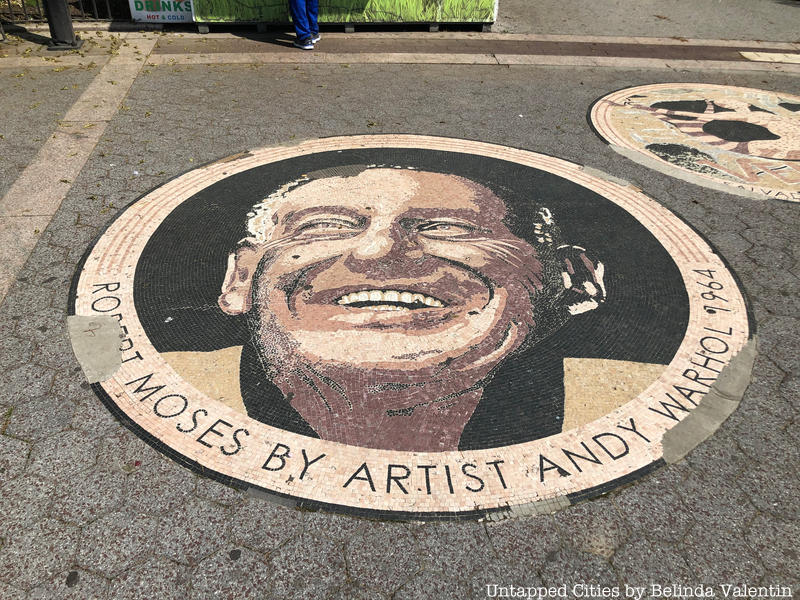
For the 1964 World’s Fair, architect Philip Johnson commissioned ten artists to decorate the New York State Pavilion, one of whom was Andy Warhol. A document from the New York City Police Department with photos of the 13 most wanted men inspired Warhol to create a mural, which was subsequently painted over. New York Governor Nelson A. Rockefeller supposedly objected to the mural because it depicted many Italian-Americans, which would anger the Italian visitors.
Once Robert Moses became President of the World’s Fair, after 26 years as Parks Commissioner, Warhol mischievously silk-screened 25 images of Moses for a replacement mural. The mural was then painted over gray. In 1998, a portrait from the mural was installed as a mosaic, which still is labeled “Robert Moses by artist Andy Warhol 1964.” you can see it today near the Gotham Plaza Entrance to Passarelle Plaza of Flushing Meadows-Corona Park.
Join us on our next tour of the Remnants of the World’s Fair to learn more about the secrets of the two international events!
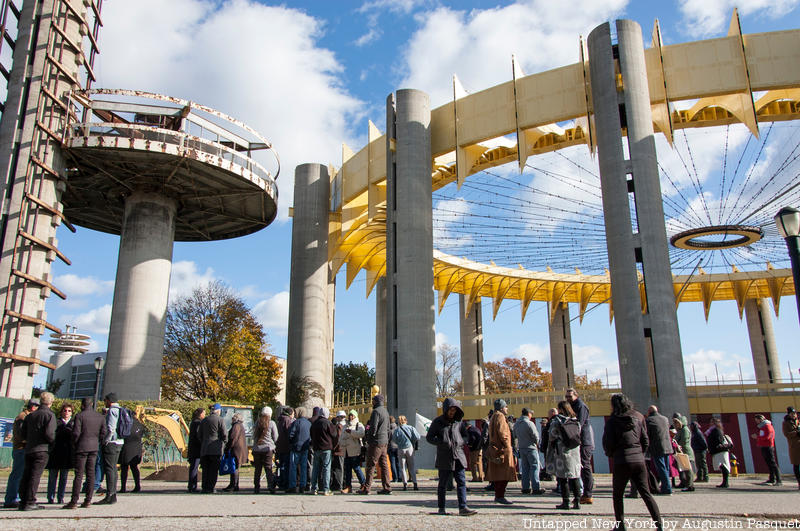
The 1964 World’s Fair is also worthy of mentioning for Philip Johnson’s New York Pavilion, a structure of much fascination following years of abandonment. It’s quite visible from all around, so not a “hidden” gem but we are excited about the restoration work that has been done over the years and the recent groundbreaking for the latest restoration efforts.
7. Olde Towne of Flushing Burial Ground
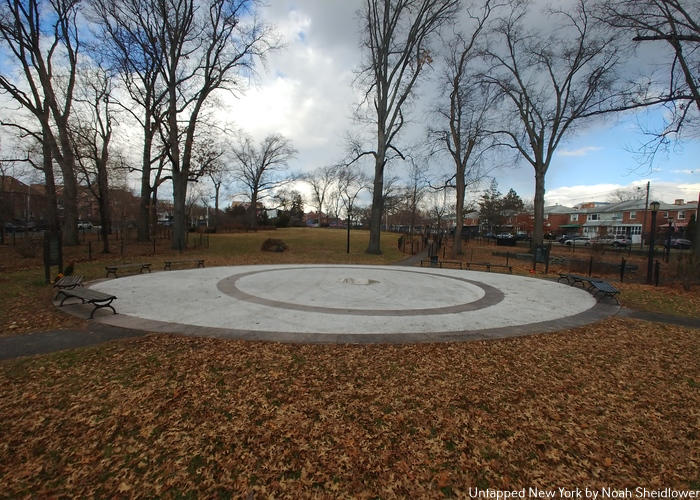
A bit of a walk from downtown Flushing, the Olde Towne of Flushing Burial Ground may appear to be just a small park in the middle of a residential area, but contained inside the park is a burial ground alternatively known as the “Colored Cemetery of Flushing.” A large circular monument notes the burial of 500 to 1,000 people, primarily African Americans, Native Americans, and victims of four major epidemics of cholera and smallpox in the mid-1800s.
Acquired by the town of Flushing in 1840, this site most likely contains the bodies of many slaves and servants of the elite of Flushing. Death certificates issued in the 1880s confirm this, with more than half of the buried being children under the age of five. The site was transferred to the city under the jurisdiction of the Parks Department in 1914.
However, in 1936, Parks Commissioner Robert Moses decided to build a modern playground on the site of the burial ground. Local activist Mandingo Tshaka halted the plans of renovating the cemetery to preserve its history. In 2004, $2.67 million was allocated to this site, leading to the creation of a historic wall engraved with the names from the only four headstones remaining in 1919.
8. Flushing Greens: One of the Oldest Parks in Queens
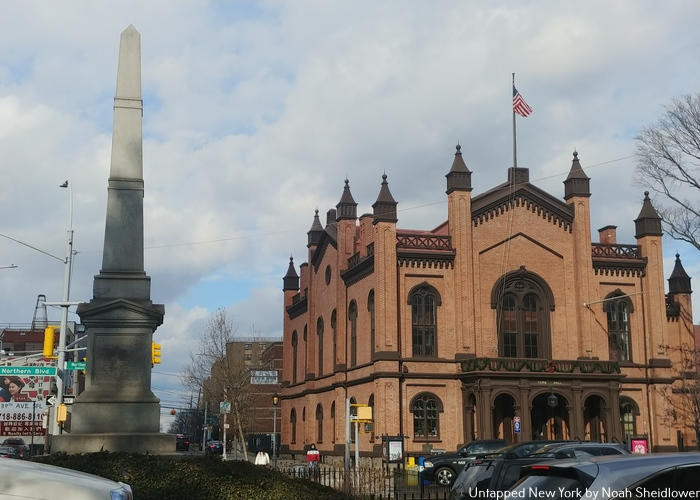 Flushing Park Civil War Memorial next to Flushing Town Hall
Flushing Park Civil War Memorial next to Flushing Town Hall
Situated in the middle of Northern Boulevard right across the street from the Flushing Town Hall is Flushing Greens, one of the oldest parks in Queens formally acquired in 1875. Known until 1942 as Flushing Park, the park was home to the King Neptune Fountain until it was demolished in 1947. The sculpture depicted the Roman sea god, flanked by four mermaids, and was supposedly hauled away by Robert Moses to be melted into wartime munitions. In its place stands a bronze and granite memorial to Alfred J. Kennedy, a Whitestone native who was a commander in the Spanish-American War.
The space also contains the Flushing Memorial, a pink marble statue of a winged female figure whose base says “THE WORLD WAR / IN MEMORY / OF THOSE WHO GAVE THEIR LIVES.”
9. Flushing’s Food Courts
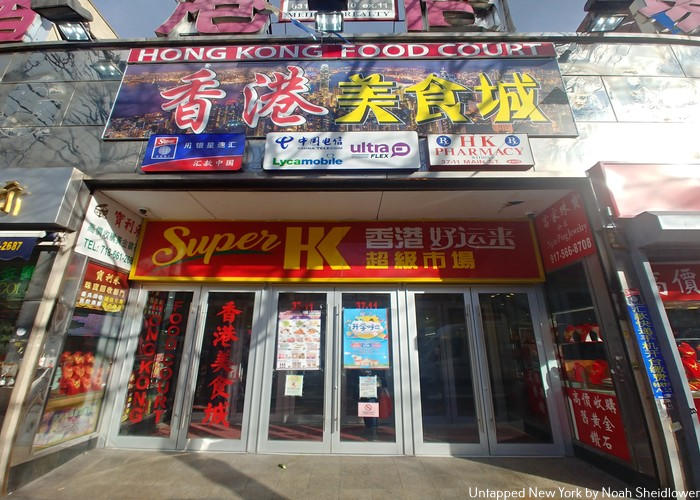 Super HK Food Court
Super HK Food Court
When we think of Flushing, some of us quickly envision Flushing New World Mall, a massive food and shopping paradise with a full grocery, many upstairs shops for beauty and health products, and an entire downstairs food court with around 30 vendors. Although most first-timers and Flushing residents love New World Mall, with its selection of food gems from Lanzhou noodles to Uyghur cuisine, there are a handful of other food courts to check out in Flushing that are a bit more obscure.
Flushing’s cousin to New World Mall is the New York Food Court, located in a rather unassuming building with a large selection of Chinese options like dry hot pot, Taiwanese chicken, and Korean cooking. A bit smaller but much newer is Super HK Food Court located right on Main Street, which houses a number of dumpling stores, food from Shaanxi province, and Sichuan seafood. Queens Crossing, a modern plaza that houses many offices, also contains a smaller food court with Sichuan hot pot, old-style dim sum, and bubble tea. The Landmark Quest Mall across the street from New World Mall contains a handful of food stalls like a steamed rice roll spot and a Taiwanese dumpling stall. Although the basement of Golden Mall has closed, the top floor still remains open with a handful of cramped stalls like a lamb noodle soup spot.
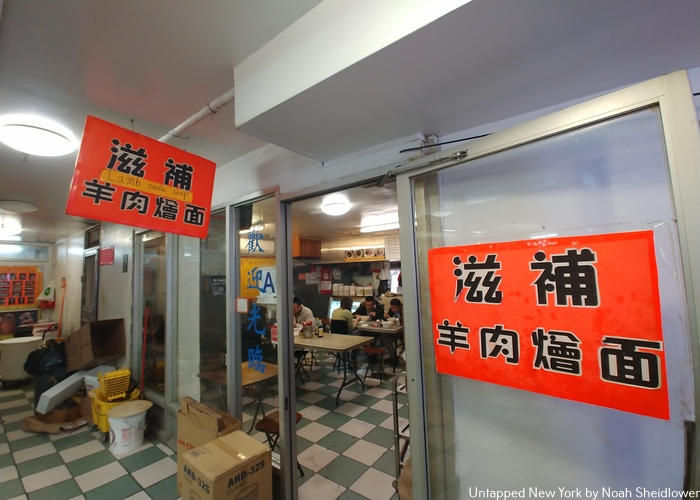 Lamb Noodle Soup Restaurant on the second floor of Golden Mall
Lamb Noodle Soup Restaurant on the second floor of Golden Mall
10. The Free Synagogue of Flushing
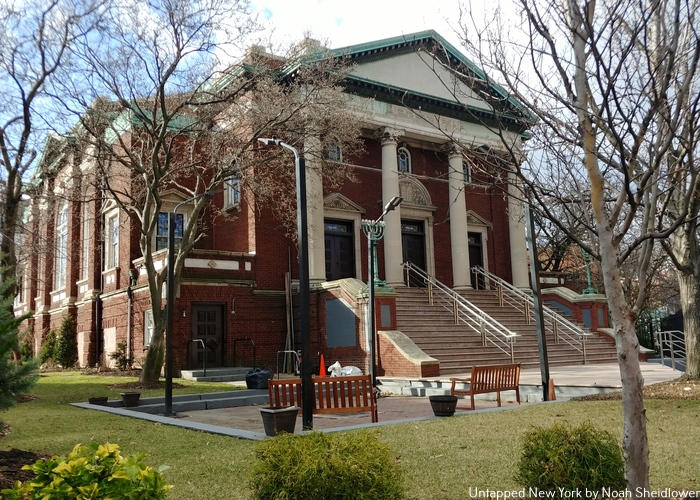 Free Synagogue of Flushing
Free Synagogue of Flushing
The Free Synagogue of Flushing, founded in 1917, has a fascinating history as well as beautiful neoclassical architecture featuring Tiffany-style stained glass windows and a domed ceiling designed around a Star of David. The Hebrew Women’s Aid Society opened the Free Synagogue of Flushing so that all Jewish Flushing residents could attend a synagogue that had freedom of the pulpit, freedom of religious expression and philosophy, and equality among men and women. The idea of a free synagogue came from the philosophy of Rabbi Stephen Wise, who promoted the Reform Judaism movement.
In the history of the synagogue, the organization writes “While the demographics in Flushing have radically changed since it was first established, the Free Synagogue remains loyal to the inscription above its magnificent neo-classical facade which reads, “For mine house shall be called a house of prayer for all people” (from the book of Isaiah). In recent months, due to a rise in anti-Semitism, the synagogue has been advised of Homeland Security and the FBI to meet guests before they attend services. You can find out how to contact the synagogue on its website.
11. The Weeping Beech
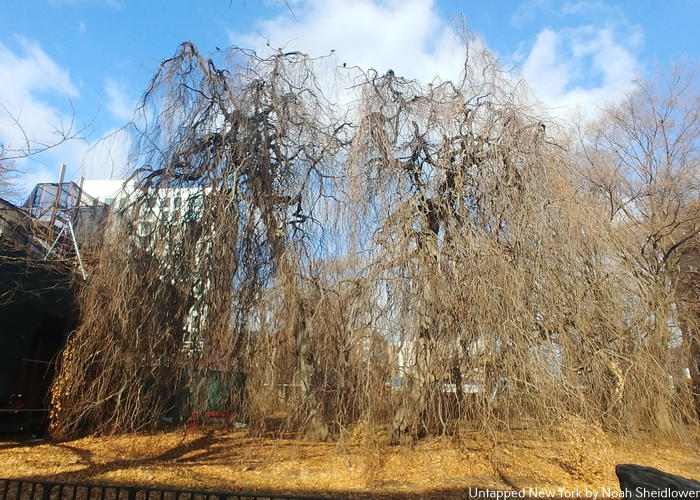 Weeping Beech park
Weeping Beech park
Housed in Kingsland Homestead, the only surviving example of 18th-century architecture in Flushing, the Queens Historical Society features a significant number of artifacts from the past few centuries. Kingsland Homestead was built in 1785 by Quaker farmer Charles Doughty and was relocated twice since it was built.
The Queens Historical Society features an entire exhibit devoted to the history Kingsland Homestead, which became the first landmark in Queens in 1965. Additionally, QHS houses a Victorian parlor room modeled to appear as it would have in 1870 and an exhibition on the rich horticultural history of Queens.
Right next to the house is the Weeping Beech Tree park, which housed the first of its species in the United States until it died in 1998. Planted by nursery owner Samuel Parsons in 1847, the Weeping Beech cultivar was brought to America from Belgium and was given landmark status in 1966. Its very tall offspring can be found in the park today and it is believed that all Weeping Beech trees in the country are descended from this first tree.
12. World’s Fair Replica Benches

At the Queens Botanical Garden, there are replicas of benchesfrom the 1939 and 1964 World’s Fairs, six of which surround the newly renovated Unity Garden. Using modern and sustainable materials, the Queens Botanical Garden worked with Kenneth Lynch & Sons, the creators of the original 1939 World’s Fair Bench, to create replicas.
The Garden has created a bench adoption program in which donors contribute $5,000, choose an inscription on the bench, and choose either a 1939 or 1964 bench replica for the garden.
13. Voelker Orth Museum, Bird Sanctuary & Victorian Garden
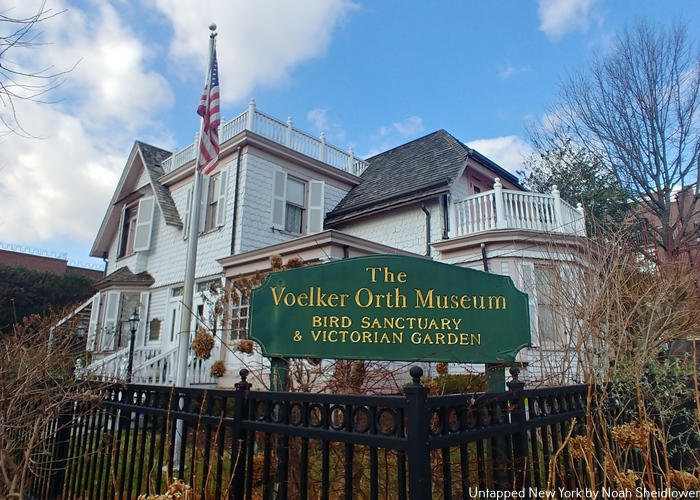
A ten minute walk from downtown Flushing, the Voelker Orth Museum, Bird Sanctuary & Victorian Garden preserves the horticultural history of Flushing and serves as a remembrance of the family that inhabited the home for almost a century. The museum also features artwork from lesser-known artists like Alexander Meshibovsky, whose landscapes depict parks and estates in Queens and Nassau County.
The house, built in 1891, was purchased in 1899 by Conrad Voelker, a German-American publisher of German language newspapers. After Voelker’s death, his daughter Theresa, her husband Dr. Rudolph Orth, and their daughter Elisabetha moved into the house. To preserve her family’s legacy, Elisabetha bequeathed her estate to establish the museum, which contains many photographs of the family and many of the family’s books. The museum also serves as the location of small concerts, the Holiday Historic House Tour, jewelry workshops, and even Oktoberfest events, which offer both German and Korean cooking.
14. The Bowne House, One of the Oldest Buildings in NYC
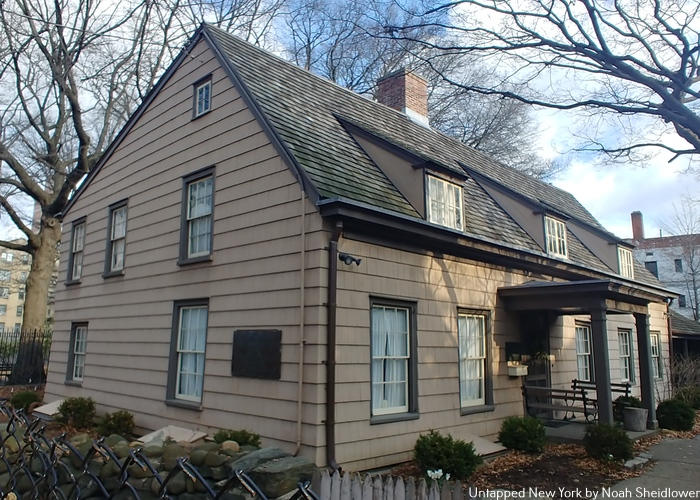 Bowne House
Bowne House
The Bowne House, one of the oldest buildings in the five boroughs, was built in 1661 by John Bowne, an English immigrant who is honored as a pioneer of the struggle for religious freedom in America. The Bowne House was the first place for worship for the Quakers in Flushing, built after Bowne and others fought for the right of Quakers to practice their religion and have equal rights in Dutch New Amsterdam. Built using English building techniques but based on a Dutch plan, the house mixes together the two architectural styles found in colonial New York.
The Bowne House has been a museum since 1947 and hosts visitors, tours, and researchers. Most of the museum’s 5,000 objects are original to the house.
15. A Hidden Chinese Herbal Medicine Shop
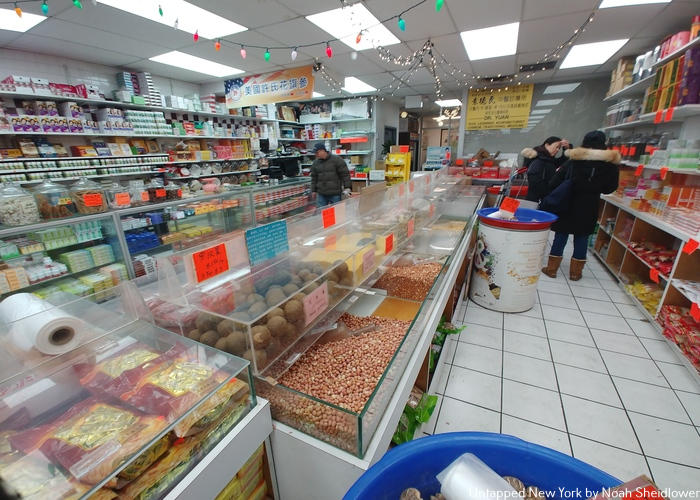 Tung Ren Tang
Tung Ren Tang
Tucked away right by the Flushing LIRR station is NY Tung Ren Tang, a traditional Chinese medicine store featuring many products from Hong Kong. Medications like Qu Feng Huo Luo Dan, which helps resolve bone pain, are found all throughout the store, as well as a large number of ginseng products grown in Wisconsin. In the center of the store are nuts, spices, herbs, and dried goods like fruit and roots which help with a variety of physical ailments.
Traditional Chinese medicine, whose origins date back almost 4,000 years, is used so that the body’s vital energy, called qi, circulates channels called meridians that connect to bodily organs. Many traditional Chinese medicine stores in Flushing have closed, but a handful remain open for those looking to remain healthy or understand a bit of Chinese history.
16. A Partially Buried Flushing Creek
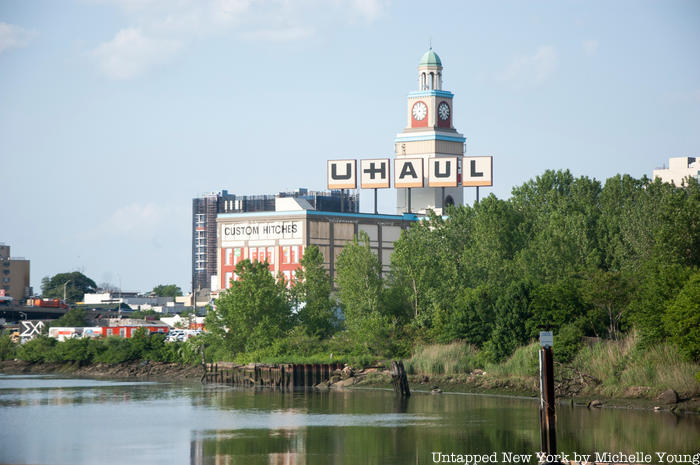
Also known as Flushing River, this waterway flows mainly within Flushing Meadows Park, but its history remains rather hidden today. The creek has dealt with much modification in the 20th century. For the 1939 World’s Fair, the southern part of the creek was expanded into the Meadow and Willow Lakes, while a portion of the creek was buried prior to the 1964 World’s Fair.
Both the town of Flushing and the creek are named after the Dutch port of Vlissingen. On the present day site of the Long Island Expressway, an Englishman named Robert Coe built a house near the creek. The pollution of the creek at the hands of the Brooklyn Ash Removal Company in the mid 1800s is described in F. Scott Fitzgerald’s The Great Gatsby.
The New York and Flushing Railroad constructed a railroad across the creek in the 1850s, and by the 1870s the LIRR’s Whitestone Branch crossed the creek until it closed due to lack of profits. Photographs from the early 1900s showcase the Willow Bank estate of the Lawrence family as well as the Wahnetah Boat Club, founded in 1900 which hosted many water sporting events. Efforts taken in the 1970s and 1980s helped to redevelop the creek away from its polluted state, which posed a health hazard to many nearby residents.
17. A Forgotten Marker to an Important Speech
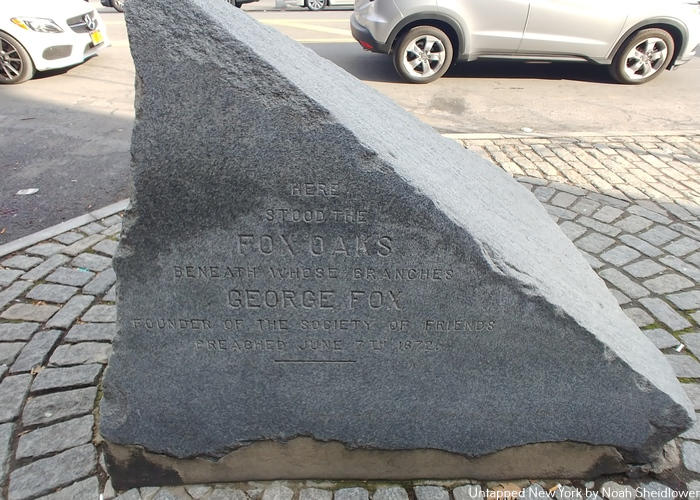 George Fox Stone
George Fox Stone
On Bowne Street in downtown Flushing, the George Fox Stone marks the location of the Fox Oaks, under whose branches George Fox, the founder of the Religious Society of Friends or Quakers, gave a speech on June 7, 1672. The stone, which has an irregular triangular shape, was placed by the Flushing Historical Society in 1907.
George Fox was an Englishman who rebelled against religious and political authorities through creating a new branch of Christianity that stressed people’s ability to access “the light within,” or “that of God in everyone.” Fox’s Quakers soon spread to the United States, where Fox spent years visiting Quaker settlements and giving speeches. In Flushing, Fox planned on delivering a sermon at the Bowne House across the street, but because of space limitations he spoke in John Bowne’s garden beneath two oak trees. These two trees, the Fox Oaks, were destroyed in 1863, but the site of his speech remains marked by the stone.
Join us on our next tour of the Remnants of the World’s Fairs!






